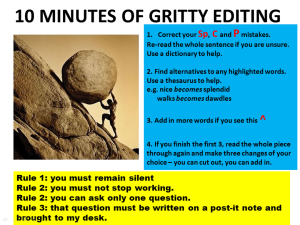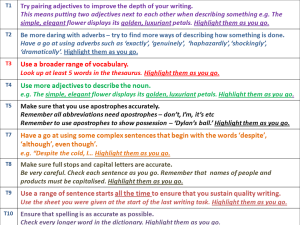This academic year has heralded a profound change in my approach to assessment. I now mark with feedback strategies in mind. Some classic blog posts have influenced my thinking: Tom Sherrington’s, David Didau’s and Mary Myatt’s.
It is not easy to mark and plan simultaneously. If our students are to both respond thoughtfully and ‘close the gap’, our assessment must be detailed, purposeful and strategic. The structure and organisation of the improvement lessons and tasks has to be at the forefront of our minds at the point of marking. Without rigourous planning, these improvement lessons, which are a test of our flexible thinking, can become – and I am speaking from experience here – a complete shambles. Remember this too: DIRT (directed improvement and reflection time) is dedicated to learning that students have already struggled with. This inevitably has implications on how smoothly the lesson will run.
Try asking these questions:
· Which is most suitable – a redraft of the original task or a new approach to the learning?
· How much curriculum time do I realistically have available and how can this be best used?
· How will I model and scaffold the learning again (taking into account that we have identified weaknesses and not strengths)?
· What will I do if the initial improvement task is unsuccessful?
Below are some strategies I am developing in my English lessons.
10 minutes of gritty editing. The first thing I always do – the ‘starter’ if you like – is that I get my students to respond to spelling, punctuation and grammar errors which I have circled and coded. I insist on complete silence (to avoid 25 helpless cries of ‘Sir’) and ensure that dictionaries, thesauruses, green pens – so that I can easily identify their editing – and post-its are available. They must edit alone. If students want to ask a question – only one each – then it can be written on a post-it note and stuck on my desk. I also highlight any words I feel they could find a better alternative for and indicate with questions and symbols where they need to elaborate. My colleague, Kate Bloomfield, uses asterisks in the margins to indicate the number of errors per line – this encourages students to seek and rectify the mistakes themselves.
Redrafting. If we just ask students to redraft, they will inevitably rewrite their original with better handwriting. A pointless waste of time. First we must model the editing process carefully. Some students may need help with concision. David Didau’s post this week – here – on encouraging his students to cut 20% of the content is a great strategy. Others struggle with elaboration. My colleague, Gav McCusker, asks his students to edit creative writing in layers – add a layer of similes, a layer of vivid verbs etc.
When can I find the time for redrafting? Time in our modern curriculum, unfortunately, does not allow for redrafting everything. Instead, we can quickly redraft at paragraph or even sentence level (see my post on ‘the sentence escalator’ here for some ideas). Setting DIRT as homework has been incredibly successful I have found, especially if I mark the first draft only for improvement, withholding levels for the final draft produced at home. My less-able year 11 group use our fortnightly Friday, period 5 lesson to type up and improve a piece of work I have marked from the past two weeks. The line “the weekend does not start until you have improved” has become my refrain.
Creating new tasks focused on target areas. Allowing ourselves to become completely blinkered by the power of the redrafting process might be a mistake. If a student’s work is based on poorly conceived ideas, or simply does not cut the mustard, starting from scratch on a new or similar task creates a useful clean slate. New tasks show students that writing knowledge must be remembered and transferred to new contexts; they also enable us to manage the process in a faster, sharply-focused way. After feeding back on a Y9 creative writing task written from the perspective of a WW2 soldier, I asked students to write a descriptive paragraph in response to a wartime photograph using the following improvement targets (I had written the ‘t-numbers’ in their books):
Modelling and scaffolding. This is where DIRT gets hard. How do we model and scaffold improvement strategies with a mixed-ability class who may need signposting in a multitude of directions? How can we simultaneously provide 30 students with the individual guidance needed to ‘close the gap’? You will notice from the above slide that I have found one way of solving this. The improvement task is linked to the targets as well as 10 italicised scaffolds.
Another strategy that I have mentioned in a previous post is DIRTy modelling. The teacher writes a paragraph or so with the whole gamut of improvement areas covered and shares it with the class – students identify how they can improve by seeing how the teacher has met their targets in the model.
Reflecting on what went well. If you double-tick excellent passages and sentences, students can reflect and write analytically about why you have ticked here. It is a great way not only of helping students to reflect on positives, but also of reinforcing analytical writing techniques – the analysis, in this case, is of their own writing. Comparative writing techniques can be worked on through highlighting a good and not-so-good sentence and asking students to write a comparison of the two, explaining why one is more sophisticated or accurate than the other.
Drills. Certainly not fashionable, but probably very effective. Write out your spelling mistakes 5 times. Write out 5 sentences with a correctly used semi-colon. Write out 5 sentences beginning with an …ing verb etc.
Re-teaching. Why are we so frightened of repeating ourselves? Why not just go over all the learning once more, irrespective of who got it the first time round? The research that Hattie and Yates have surveyed convincingly argues that we should repeat learning, that students should over-learn. If we repeat something that some students already know, we are reinforcing and strengthening this learning, so that it is not forgotten. Cognitive science research demonstrates this, yet many of us are frightened that repetition means no learning. As long as this kind of feedback is speedy and focused, surely it has a place, particularly when we need to feed back quickly.
Flexible curricular. If we are serious about improvement, we must centralise the ‘feed-forward’ process – thanks to David Fawcett‘s post for introducing me to this term – in the curriculum, streamlining superfluous subject content where we can. Our ruthlessness will be to our students’ benefit. Not only should our short-term planning be directed by assessment, so should our long-term planning. The next unit of work we plan, and even next year’s curriculum, must be informed by our findings. Over-prescriptive curricular and schemes-of-work can be the enemy of learning.
Ultimately, the planning and management of improvement tasks is more challenging than it first appears. I am very much a novice. My hunch is that the more strategies we have at our fingertips, the more skilful we can become at ‘closing the gap’.
Related blog posts:
My post – Marking: minimum impact for maximum pleasure.
Harry Fletcher-Wood – Slovenly language and foolish thoughts: howcan I help my students get better at writing history essays?
Canons Broadside – DIRTy ToEs – Differentiation by Assessment
Shaun Allsion – Marking Matters
Mark Miller – Revision Before Redrafting
Belmont Teach – Fast Feedback



Thanks for this post. I really enjoyed it. DIRT is a staple in my classroom and it has really changed me teaching and the kids’ learning. I now have to tighten up the DIRT to improve the students’ focus, concentration and independence so will be implementing your rules. Thank you
Reblogged this on The Echo Chamber.
A brilliant read and a worthy addition to many top blogs about assessment.
What went well: I particularly like the new tasks but focusing on previous feedback and targeted areas.
Even better if: I had written this blog.
Damian
good post thx 066 arabidze
Pingback: Can we ever praise too much? | Meols Cop High School
Pingback: Differentiating the responsive way | Reflecting English
Reblogged this on Do Less, But Better.
Pingback: Time-management in education: a win-win solution? | Reflecting English
Reblogged this on History Bluff and commented:
I’ve got as far as improving my marking and making it more efficient by using codes and more focused feedback. Here are some great ideas I intend to now use to improve reflection and re-drafting in class.
Pingback: My RAG123 marking experiment | mrbenney
Pingback: Three blog posts on marking and feedback | Evidence into practice @ Turnford
Pingback: The Everest writing scaffold | Reflecting English
I stumbled upon your blog and saw this post, drawn in by both the phrase “strategic marking” and the mostly capitalized “DIRT-y.” As for the latter, this is my first experience with this acronym, but I’m happy to know it now. And as for the first, I was intrigued because I just finished grading some essays and found that, in spite of my rubric, I wished I had been a little more strategic in how I marked my students’ writing pieces. I was surprised to discover that this post had not only to do with teachers marking writing but also students themselves during this very important time of formative “directed improvement.”
I’m excited about so many of these ideas! For instance, I love Kate Bloomfield’s use of the asterisk as a tool for students to recognize and fix errors themselves. I feel like this would work well as a drill exercise (which you admit is not “fashionable” but ultimately beneficial). We could write sample paragraphs with errors included, give them to the students in the form of a worksheet, and tell them how many errors there are throughout. It would probably work well with students moving from working with a group, then a partner, and then individually. It could be great practice before students move on to editing their own writing.
I also really like your tactic of marking what’s positive and then asking students to explain why. I will definitely be using this one in the near future.
Thanks for all of the helpful ideas that you’ve collected and elaborated on here!
Pingback: What if we didn’t mark any books? | Reflecting English
Pingback: What if we didn’t mark any books? | Teachers Blog
Pingback: A directory of my writing posts | Reflecting English
Pingback: Marking and Feedback | Meols Cop High School
Pingback: Distilling the best out of words | Reflecting English
Pingback: #TLT14 – Feedback Matters | Class Teaching
Great stuff. I’ll be using much of this on Monday, though with the adverb advice deleted – find a better verb is my mantra
Keep up the good work #coys
Pingback: Feedback: built-in or added-on? | Reflecting English
Pingback: Getting DIRTy | barrydunn
Pingback: Slamming the door on bad writing habits | Reflecting English
Pingback: A directory of my posts on teaching writing | Reflecting English
Pingback: Three blog posts on marking and feedback | Evidence into practice
Pingback: Planning to be great | Class Teaching
Pingback: Blogs for English Teachers – English at Stover School
Pingback: Feedback: When it Works and When it Doesn’t – Teachers as Learners @ JCG